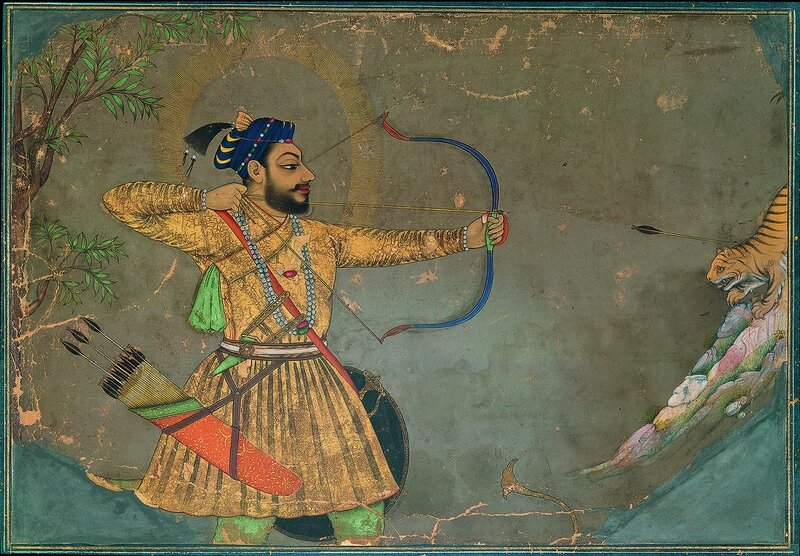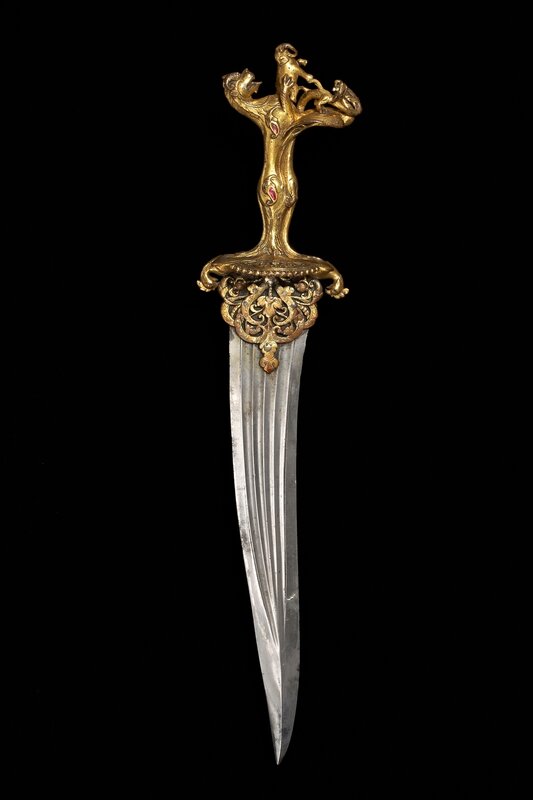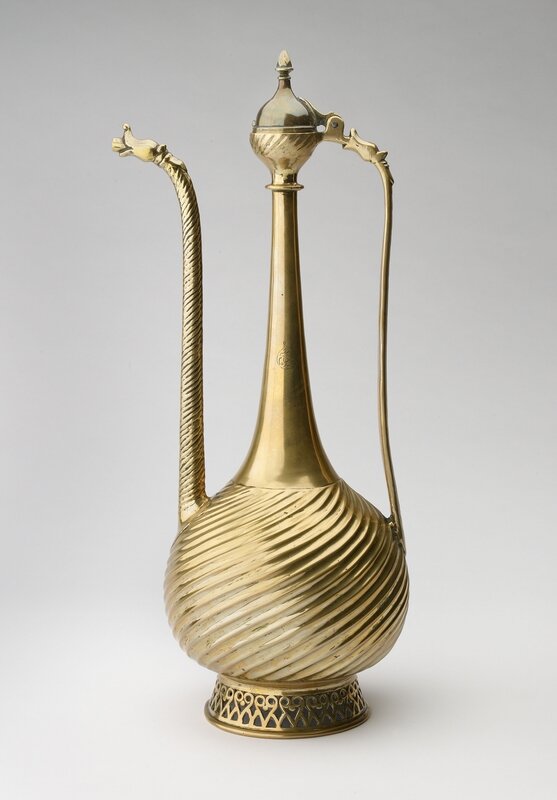"Sultans of Deccan India, 1500–1700: Opulence and Fantasy" at the Metropolitan Museum of Art on April 20
Sultan ‘Ali ‘Adil Shah II Slays a Tiger. Attributed to the Bombay Painter (probably Abdul Hamid Naqqash), Bijapur, ca. 1660. Ink, opaque watercolor, gold, and probably lapis-lazuli pigment on paper, 8½ × 12⅜ in. (21.5 × 31.5 cm). The Ashmolean Museum, Oxford. Lent by Howard Hodgkin.
NEW YORK - The Deccan plateau of south-central India was home to a succession of highly cultured Muslim kingdoms with a rich artistic heritage. Under their patronage in the 16th and 17th centuries, foreign influences—notably from Iran, Turkey, eastern Africa, and Europe—combined with ancient and prevailing Indian traditions to create a distinctive Indo-Islamic art and culture. Opening at The Metropolitan Museum of Art on April 20, the landmark exhibition Sultans of Deccan India, 1500–1700: Opulence and Fantasy will bring together some 200 of the finest works from major international, private, and royal collections. Featuring many remarkable loans from India, the exhibition—which is the most comprehensive museum presentation on this subject to date—will explore the unmistakable character of classical Deccani art in various media: poetic lyricism in painting; lively creations in metalwork; and a distinguished tradition of textile production. A highlight will be the presentation of all of the known masterpieces and several new discoveries in painting, the greatest art of the Deccan. Another highlight will be the display of diamonds—some of the largest ever found—that originated in the great mines of the Deccan.
The exhibition is made possible by the Gail and Parker Gilbert Fund, the Placido Arango Fund, the E. Rhodes and Leona B. Carpenter Foundation, the National Endowment for the Arts, and Cynthia Hazen Polsky and Leon B. Polsky. It is supported by an indemnity from the Federal Council on the Arts and the Humanities.
Dagger with Zoomorphic Hilt. Probably Bijapur, mid-16th century. Hilt: gilt bronze inlaid with rubies, blade: watered steel L. 16½ in. (42 cm), W. 3⅜ in. (8.7 cm). The David Collection, Copenhagen. Image: The David Collection, Copenhagen (photograph by Pernille Klemp).
The population of the Deccan plateau by the 16th century included immigrants from Central Asia and Iran, African military slaves, native-born Muslim nobles, and European missionaries, merchants, and mercenaries. As a result, it boasted one of the most cosmopolitan societies of the early modern world. To provide a glimpse into this dynamic, yet little-known society, the exhibition will focus chiefly on the courtly art of the kingdoms of Bijapur, Ahmadnagar, Bidar, and Golconda. These dynamic centers of royal patronage drew some of the greatest artists, writers, poets, and musicians of the period.
The population of the Deccan plateau by the 16th century included immigrants from Central Asia and Iran, African military slaves, native-born Muslim nobles, and European missionaries, merchants, and mercenaries. As a result, it boasted one of the most cosmopolitan societies of the early modern world. To provide a glimpse into this dynamic, yet little-known society, the exhibition will focus chiefly on the courtly art of the kingdoms of Bijapur, Ahmadnagar, Bidar, and Golconda. These dynamic centers of royal patronage drew some of the greatest artists, writers, poets, and musicians of the period.
Ewer with Dragon Heads, Deccan, first half of 17th century. Brass, with traces of gilding. H. 20⅛ in. (51 cm), W. 7⅞ in. (20 cm), D. 6¼ in. (16 cm). The Ashmolean Museum, Oxford. Presented by Miss Eleanor Butler, in memory of her father Dr. A. J. Butler, 1976. Image: © Ashmolean Museum, University of Oxford
The golden age of Bijapur under the rule of Sultan Ibrahim Adil Shah II (1580–1627) defines the spirit of Deccani art. Masterpieces in painting by the leading court artist Farrukh Husain will demonstrate the refined and lyrical style that influenced much of Deccani art. Ahmadnagar’s African nobility included the legendary Abyssinian Malik Ambar (1548–1628), whose portraits will be included among other rare surviving works. Numerous examples of the celebrated bidri metalwork tradition from the kingdom of Bidar will also be shown. These feature a base composed of a blackened alloy of zinc and copper with thin sheets of silver inlay in striking designs.
From antiquity until the 18th and 19th centuries, when diamonds were discovered in Brazil and Africa, India was virtually the sole source for these precious gems. The extremely rich mines of Golconda produced some of the largest known diamonds. Whether given as diplomatic gifts or traded by merchants, India’s diamonds reached an appreciative audience among European royalty. The Deccan, already astonishingly wealthy, was further enriched by foreign demand for these gems. Among the treasures from Golconda—whose diamond mines were the source of such diamonds as the legendary Kohinoor—will be a group of magnificent gems from international royal collections, including the “Idol’s Eye” and “Agra” diamonds.
Calligraphic ‘Alam in the Shape of a Falcon. Golconda, 17th century. Perforated gilt copper. H. 13¾ in. (34.9 cm), W. 8 in. (20.3 cm). Victoria and Albert Museum, London, Image: © Victoria and Albert Museum
Also to be shown are spectacular large painted and printed textiles (kalamkaris), several over nine feet in height and all richly painted with motifs drawn from Indian, Islamic, and European art. These will be shown along with sumptuous royal objects made of inlaid and gilded metal, precious jewels, carved wood, and stone architectural elements, many of which draw inspiration from the art of Safavid Persia and Ottoman Turkey.
April 20–July 26, 2015 - First-floor special exhibition gallery (Gallery 199)
A Parrot Perched on a Mango Tree; a Ram Tethered Below, ca. 1670. Golconda. Islamic. Opaque watercolor and gold on paper. Jagdish and Kamla Mittal Museum of Indian Art, Hyderabad (76.438).

/https%3A%2F%2Fprofilepics.canalblog.com%2Fprofilepics%2F1%2F0%2F100183.jpg)
/https%3A%2F%2Fstorage.canalblog.com%2F03%2F02%2F119589%2F96711876_o.jpg)
/https%3A%2F%2Fstorage.canalblog.com%2F11%2F31%2F119589%2F94773502_o.jpg)
/https%3A%2F%2Fstorage.canalblog.com%2F20%2F83%2F119589%2F94772815_o.jpg)
/https%3A%2F%2Fstorage.canalblog.com%2F26%2F72%2F119589%2F75604929_o.jpg)
/https%3A%2F%2Fstorage.canalblog.com%2F59%2F60%2F119589%2F26458628_o.jpg)







/http%3A%2F%2Fstorage.canalblog.com%2F46%2F09%2F119589%2F122328823_o.jpg)
/http%3A%2F%2Fstorage.canalblog.com%2F19%2F56%2F119589%2F121033526_o.jpg)
/http%3A%2F%2Fstorage.canalblog.com%2F57%2F05%2F119589%2F111930948_o.jpg)
/http%3A%2F%2Fstorage.canalblog.com%2F05%2F88%2F119589%2F110900108_o.jpg)